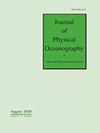Vertical Energy Fluxes Driven by the Interaction Between Wave Groups and Langmuir Turbulence
IF 2.8
2区 地球科学
Q1 OCEANOGRAPHY
引用次数: 0
Abstract
Data from an air-sea interaction tower are used to close the turbulent kinetic energy (TKE) budget in the wave-affected surface layer of the upper ocean. Under energetic wind forcing with active wave breaking, the dominant balance is between the dissipation rate of TKE and the downward convergence in vertical energy flux. The downward energy flux is driven by pressure work, and the TKE transport is upward, opposite to the downgradient assumption in most turbulence closure models. The sign and the relative magnitude of these energy fluxes are hypothesized to be driven by an interaction between the vertical velocity of Langmuir circulation (LC) and the kinetic energy and pressure of wave groups, which is the result of small-scale wave-current interaction. Consistent with previous modeling studies, the data suggest that the horizontal velocity anomaly associated with LC refracts wave energy away from downwelling regions and into upwelling regions, resulting in negative covariance between the vertical velocity of LC and the pressure anomaly associated with the wave groups. The asymmetry between downward pressure work and upward TKE flux is explained by the Bernoulli response of the sea surface, which results in groups of waves having a larger pressure anomaly than the corresponding kinetic energy anomaly, consistent with group-bound long wave theory.波群与朗缪尔湍流相互作用驱动的垂直能量通量
利用海气相互作用塔的数据关闭了上层海洋受波浪影响表层的湍流动能(TKE)预算。在主动破浪的高能风力作用下,TKE 的耗散率与垂直能量通量的向下汇聚之间的平衡占主导地位。向下的能量通量是由压力功驱动的,而 TKE 的传输是向上的,这与大多数湍流闭合模型中的向下梯度假设相反。假设这些能量通量的符号和相对大小是由朗缪尔环流(Langmuir circulation,LC)的垂直速度与波群的动能和压力之间的相互作用驱动的,而后者是小尺度波流相互作用的结果。与以前的模拟研究一致,数据表明,与朗缪尔环流相关的水平速度异常将波浪能量从下沉区域折射到上涌区域,导致朗缪尔环流的垂直速度与波群相关的压力异常之间产生负协方差。下行压力功和上行 TKE 通量之间的不对称可以用海面的伯努利响应来解释,它导致波群的压力异常大于相应的动能异常,这与波群约束长波理论是一致的。
本文章由计算机程序翻译,如有差异,请以英文原文为准。
求助全文
约1分钟内获得全文
求助全文
来源期刊
CiteScore
2.40
自引率
20.00%
发文量
200
审稿时长
4.5 months
期刊介绍:
The Journal of Physical Oceanography (JPO) (ISSN: 0022-3670; eISSN: 1520-0485) publishes research related to the physics of the ocean and to processes operating at its boundaries. Observational, theoretical, and modeling studies are all welcome, especially those that focus on elucidating specific physical processes. Papers that investigate interactions with other components of the Earth system (e.g., ocean–atmosphere, physical–biological, and physical–chemical interactions) as well as studies of other fluid systems (e.g., lakes and laboratory tanks) are also invited, as long as their focus is on understanding the ocean or its role in the Earth system.

 求助内容:
求助内容: 应助结果提醒方式:
应助结果提醒方式:


